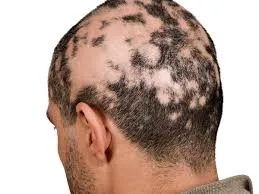Hair is often an important part of our identity, but what happens when it starts falling out unexpectedly? For many, the answer could be alopecia areata, an autoimmune disorder that causes sudden patchy hair loss. It is one of the most prevalent hair loss disorders, with a reported worldwide lifetime incidence of 2%, with no preference for gender. Anyone can be affected, regardless of age, gender, or ethnicity. It can develop at any stage of life, but the mean age of onset is mid-adulthood. People with a family history of autoimmune disorders (e.g., type 1 diabetes, rheumatoid arthritis, thyroid disease) may have a higher risk of developing alopecia areata. Other associated systemic dermatological conditions include vitiligo and psoriasis.
While alopecia areata is not life-threatening, it can be a source of distress for those who experience it. It can pose a cosmetic concern, profoundly impacting one’s self-esteem and quality of life. It is critical for doctors to consider these psychological comorbidities when managing patients with this condition. This article will explore the basics of alopecia areata, including its pathogenesis, clinical presentation, and treatment options.
Etiology and Pathogenesis
The hair cycle consists of 3 phases: anagen, catagen, and telogen.
- Anagen phase: active hair growth
- Catagen phase: hair stops growing, preparing the hair to eventually shed
- Telogen phase: resting interval where the hair is no longer growing, but remains in place (until it eventually sheds)
Alopecia areata is an autoimmune form of hair loss. Autoimmune refers to a group of diseases where the immune system mistakenly identifies a part of your body as a “threat” and attacks it. In the case of alopecia areata, the immune system attacks the hair follicles (specifically at the anagen phase), causing them to shrink and slow hair production. The hair follicle is usually protected from immune attacks (“zone of immune privilege”), but this protective mechanism breaks down due to abnormal immune signaling, causing inflammation and hair loss. Several pro-inflammatory cytokines play a key role in this process, including interleukin-15 and interferon-γ, by activating the Janus kinase (JAK) pathway, a promising therapeutic target in treating alopecia areata. The exact reason why this happens is not fully understood, but it is believed to involve a multifactorial combination of genetic, environmental, and stress-related factors. On the bright side, this attack rarely damages the hair follicles permanently, so it’s possible to regrow hair over time.
Clinical Presentation
Alopecia areata is a clinical diagnosis, presenting as localized skin-colored patches of smooth, non-scarring hair loss on the scalp (or any area with hair growth). Sometimes, you will hear the term “exclamation mark hairs” described by dermatologists for the appearance of hair follicles in this disease. Alopecia areata has the potential to progress to other variants including: alopecia totalis (total scalp hair loss) or alopecia universalis (total body hair loss).
Does the hair grow back? The short answer is yes, but this varies between patients. Some patients may experience hair regrowth without treatment in about a year without repeat episodes. Other patients may need help to regrow their hair, taking several months of treatment to see full regrowth. Some patients may also suffer from cycles of hair loss and regrowth throughout their lives, not always satisfied with the amount of hair growth they see.
Diagnosis and Workup
Alopecia areata is mainly a clinical diagnosis based on your medical history and physical examination. Quickly emerging patches of hair loss should be a cause for concern and raise clinical suspicion surrounding the diagnosis. Dermatologists may use dermoscopy (a magnifying tool to give a better view) to aid in their diagnosis. If the diagnosis remains unclear, a skin biopsy from the edge of an active hair loss patch can be beneficial; however, skin biopsies are not routinely required.
Treatment
Despite no permanent cure for alopecia areata, several treatment options can help manage the condition and encourage hair growth. Here are some common treatments:
- Corticosteroids: Intralesional (i.e., injections) and topical corticosteroids (betamethasone) are often the first-line initial treatment for alopecia areata. As anti-inflammatory drugs, they help reduce inflammation around the hair follicle as a complementary “push” to encourage hair regrowth. Injections are repeated until complete hair growth is achieved unless no improvement is observed after several months. Common side effects of the injections include skin atrophy or pigmentation changes.
- Platelet-Rich Plasma (PRP) Therapy: In this procedure, blood is drawn from the patient, processed to extract the plasma, and injected into the scalp. PRP therapy may promote hair regrowth by enhancing the activity of the hair follicles. However, due to its cost, it may be a financial burden to patients.
- JAK Inhibitors: This newer class of medications targets specific immune pathways, as described in the pathogenesis above. Extensive ongoing research demonstrates the promising therapeutic effects of JAK inhibitors, mainly tofacitinib, ruxolitinib, and baricitinib (which was FDA-approved for alopecia areata in 2022). Some clinicians and patients feel hesitant about starting this class of medications due to the FDA’s boxed warning about the risk of severe infections, malignancy, thrombosis, and adverse cardiovascular events. It is important to evaluate the benefits and risks of this treatment when speaking to your dermatologist prior to starting this medication.
- Wigs and Hairpieces: This is a helpful cosmetic solution to boost confidence in patients experiencing extensive hair loss while waiting for hair to regrow.
As this condition affects physical appearance, living with alopecia areata can be challenging due to emotional and psychological impacts. However, there are many ways that patients can learn to cope, including joining a support group and practicing self-care.
Conclusion
Alopecia areata may be unpredictable, but it’s important to remember that it does not define you. Many people with this condition find ways to manage it. Promising new treatments continue to emerge thanks to ongoing research, offering hope to those affected. If you’re experiencing hair loss and are concerned about alopecia areata, it’s always a good idea to consult with a dermatologist who can provide a diagnosis and discuss the best treatment options for you.








